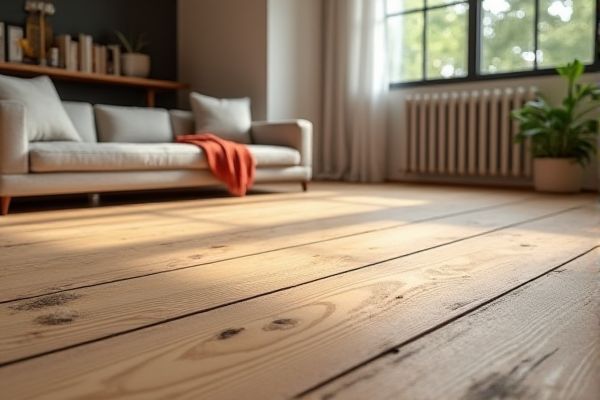
Tongue-and-groove tops offer a seamless, interlocking design that enhances stability and reduces gaps, making them ideal for smooth, uniform surfaces, while plank tops showcase individual boards with visible seams for a rustic, textured look and easier board replacement. Explore the full article to determine which top suits your style and functional needs best.
Table of Comparison
| Feature | Tongue-and-Groove Top | Plank Top |
|---|---|---|
| Construction | Interlocking wood boards using tongue-and-groove joints | Separate wood planks joined side-by-side without interlocking |
| Durability | High resistance to warping and separation | Moderate, may develop gaps over time |
| Appearance | Uniform, smooth surface with minimal gaps | Rustic look with visible seams and varied plank widths |
| Installation | More complex; requires precise fitting of joints | Simpler; planks laid side-by-side with fasteners |
| Cost | Generally higher due to intricate joinery | Lower; simpler materials and construction |
| Maintenance | Lower; joints reduce dirt accumulation | Higher; gaps can trap debris and moisture |
| Applications | Furniture tops, flooring, precise woodworking projects | Tables, benches, rustic furniture, outdoor uses |
Introduction to Tabletop Construction Methods
Tongue-and-groove tabletops feature interlocking edges that provide stability and prevent warping, making them ideal for durable furniture. Plank tops consist of wider, individual boards joined edge-to-edge, showcasing natural wood grain patterns and offering a rustic aesthetic. Choosing the right construction method affects your table's strength, appearance, and resistance to environmental changes.
What is a Tongue-and-Groove Top?
A tongue-and-groove top consists of wooden boards designed with a projecting tongue on one edge and a corresponding groove on the other, allowing the pieces to interlock securely. This construction method enhances stability, prevents gaps, and ensures a smooth, seamless surface ideal for tabletops or flooring. Understanding this design helps you choose a durable and aesthetically pleasing wooden top that resists warping and improves structural integrity.
What is a Plank Top?
A plank top consists of wide, flat wooden boards joined edge-to-edge to create a smooth, rustic surface often seen in farmhouse or traditional furniture. Unlike tongue-and-groove tops that use interlocking edges for stability, plank tops rely on surface fastening or wood glue, offering a simpler, more natural aesthetic. This type of construction highlights the natural grain and imperfections of the wood, making each plank top unique and visually appealing.
Aesthetic Differences: Tongue-and-Groove vs. Plank Top
Tongue-and-groove tops create a seamless, uniform surface with tight joints that enhance a refined, polished look, often preferred in traditional and formal settings. Plank tops display individual boards with visible seams and natural grain variations, offering a rustic, handcrafted aesthetic that highlights wood character. The choice between the two impacts the visual flow and texture, influencing whether the design leans towards sleek elegance or organic warmth.
Durability and Longevity Comparison
Tongue-and-groove tops offer enhanced durability due to their interlocking design, which minimizes gaps and resists warping over time, making them ideal for long-term use. Plank tops, while visually appealing with distinct board separations, may be more susceptible to expansion and contraction from humidity, potentially impacting longevity. Your choice depends on whether you prioritize a seamless, sturdy surface or a more traditional, rustic look that requires regular maintenance.
Installation and Construction Process
Tongue-and-groove tops feature interlocking edges that simplify alignment and create a seamless surface during installation, ensuring a secure fit with minimal gaps. Plank tops consist of individual boards laid side by side and often require additional fastening techniques, such as nails or screws, to hold them firmly in place. Your choice affects the construction process, as tongue-and-groove systems commonly reduce installation time and improve structural stability compared to plank tops.
Cost Considerations: Materials and Labor
Tongue-and-groove tops typically require more precise materials and skilled labor, increasing overall costs compared to plank tops. Plank tops use wider, simpler boards that reduce material waste and labor time, offering a more budget-friendly option. Understanding your project's budget will help you decide whether the durability and seamless finish of tongue-and-groove or the affordability of plank tops align better with your needs.
Maintenance and Repair Needs
Tongue-and-groove tops require less frequent maintenance due to their interlocking design, which reduces gaps and minimizes debris accumulation, thereby preventing potential damage. Plank tops may demand more regular upkeep since their individual boards can expand or contract, leading to visible gaps and the need for resealing or refinishing. Your choice should consider the ease of repair; tongue-and-groove sections are easier to replace individually, while plank tops might require more extensive work if damage occurs.
Best Applications for Each Tabletop Style
Tongue-and-groove tabletops excel in applications requiring durability and resistance to warping, making them ideal for outdoor furniture and workbenches where stability and moisture resistance are crucial. Plank tops showcase natural wood grain and are best suited for rustic dining tables, farmhouse-style decor, and statement pieces where visual appeal and larger surface continuity are desired. Choose a tongue-and-groove tabletop for functional strength and a plank top if Your project prioritizes aesthetic warmth and traditional craftsmanship.
Choosing the Right Top for Your Needs
Selecting between a tongue-and-groove top and a plank top depends on your desired durability and aesthetic. Tongue-and-groove tops offer enhanced stability and a smooth, uniform surface ideal for precise woodworking projects, while plank tops provide a rustic charm with visible seams and natural wood variation. Consider the intended use, maintenance preferences, and visual appeal to determine which wood top best suits your workshop or furniture needs.
 homyna.com
homyna.com